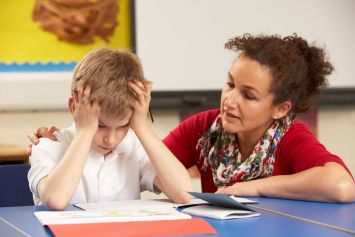7 Warning Signs of Bullying at School
Author: Dr. Kristin Condon
Bullying – both in-person and online – presents potentially serious consequences for all involved: the targeted child, children who vicariously witness the aggression, and the child bullying others. According to the National Center for Educational Statistics, one in every five students reported being bullied in 2016, and 64 percent of bullied children don’t report these experiences to adults (https://www.activekids.com/parenting-and-family/articles/10-signs-your-child-is-being-bullied).

Dr. Meg Meeker captured it well, “If your kid is being bullied at school, or elsewhere, he will bring signs home with him.” Knowing typical warning signs can help you generate safe, timely conversations with your kids. “When adults respond quickly and consistently to bullying behavior, they send the message that it is not acceptable. Research shows this can stop bullying behavior over time. Parents, school staff, and other adults in the community can help kids prevent bullying by talking about it, building a safe school environment, and creating a community-wide bullying prevention strategy,” (www.stopbullying.gov).
Some common signals that may indicate that your child is being targeted include:
1. Expressing sudden or increased reluctance to attend school or complaining of unexplainable headaches or stomachaches
Sudden onset of school fears or phobias can suggest that there are experiences unfolding socially that your child is trying to avoid. Inquire around curious or sudden changes in your child’s willingness or excitement towards school, especially if you see changes within your child’s social contacts, time engaged socially vs. being at home, or marked differences in your child’s more typical attitudes about getting to school in the morning.
2. Returning home with damaged or missing belongings or unexplained injuries
While all bullying behavior doesn’t involve physical aggression, some can. Taking note and gently asking questions about your observations can set a safe stage for a conversation that your child may struggle to initiate independently for fear of escalated attacks.

3. Neglecting to discuss friendships or other kids they spend time with while at school
Social isolation can be a signal that a child is feeling uncomfortable or unsafe when engaging with peers. Take note if your child seems to struggle to talk about positive exchanges with other kids throughout the school day. Checking in with teachers can be a helpful means to gauge if your child’s social withdrawal is an indication of something more problematic coming to the attention of other adults within the school community.
4. Appearing fearful of times when adult supervision is lower, such as riding the school bus, lunchtime, recess, or after-school activities
Kids are highly aware of these patches of time throughout the school day when their behavior may go more under adults’ radar. Simultaneously, social media and other online games are additional arenas where adult supervision is lower. Bullying behaviors often occur in these arenas due to a bully’s false sense of anonymity or disconnect from the emotional and social cues we share in-person.
5. Demonstrating a decline in academic focus or performance
Changes in more typical patterns of success in school can often be an indicator of mood fluctuations, heightened anxiety, or distracting social dynamics. Connect with teachers when you see more abrupt declines in your child’s performance, stamina in homework completion, or general enthusiasm about schoolwork.

6. Displaying greater sadness, tearfulness, anxiety, or depressed moods, especially when returning home from school
Bullying and teasing are challenging experiences for children to discuss openly with adults, as kids often fear that our response will result in a worsening of the challenging situations they are encountering socially. It takes repeated exposure and success for kids to trust that honestly discussing these topics with adults. This makes it essential that we become aware of how we get triggered and what actions we should take to constructively advocate for our kids.
7. Becoming more reluctant for you to view or follow their social media accounts
Navigating this territory around respecting your child’s privacy vs. healthy oversight of online activity is a topic in and of itself. However, if you notice shifts in your child’s activity online or openness to your viewing their accounts, this can be a key indicator of cyber-bullying or other problematic online behaviors.
To learn more about how to address concerns related to bullying, social aggression, or cyber-bullying, reach out today. We often have conversations and workshops with parents about how best to explore and respond to problematic social challenges with their kids.
Additional Resources:
https://www.stopbullying.gov/research-resources/consequences-of-bullying/index.html https://www.stompoutbullying.org
https://stopbullying.gov
https://www.pacer.org/bullying/
https://pacerteensagainstbullying.org
https://www.edutopia.org/article/bullying-prevention-resources





